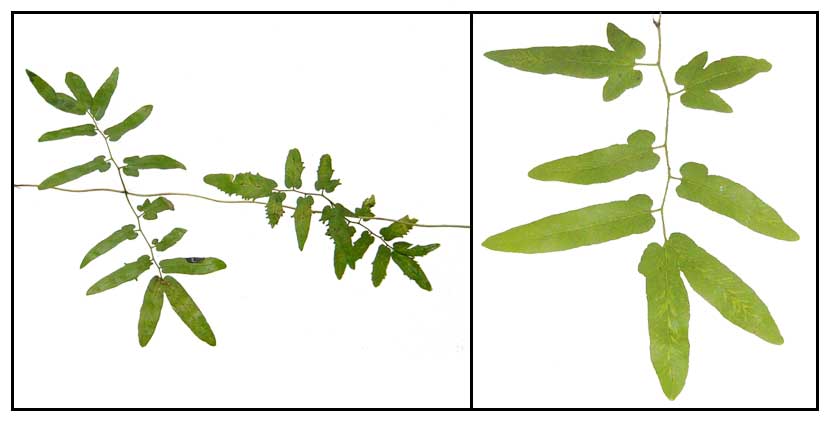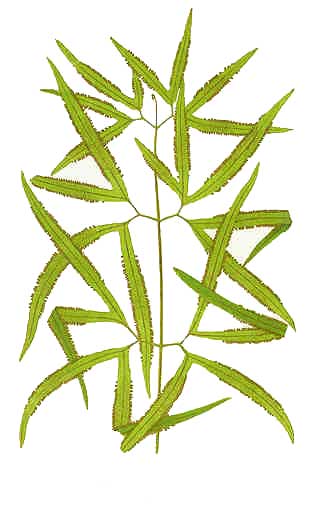| 
 Gen info Gen info
- Lygodium (climbing fern) is a genus of abut 40 species of ferns, native to tropical regions across the world. It is the sole genus in the family Lygodiaceae. The genus is largely pan-tropical, with the center of diversity in the Pacific islands, such as Borneo, the Philippines, and New Guinea. (3)
- Some Lygodium species are now considered very problematic invasive weeds in the southeastern United States, populations of which have increased more than 12-fold in the past decade. (3)
- Leonardo Co's database lists nine native Lygodium species: in the Philippines: Lygodium auriculatum, L. circinnatum, L. flexuosum, L. japonicum, L. longifolium, L. merrillii, L. microphyllum, L. salicifolium, and L versteegii. Â (10)
- Note: Schizaeaeae is a family
of ferns in the order Schizaeales. In the Pteridophyte Phylogeny Group classification of 2016, it included only two genera. Alternatively, two families kept separate in PPG I, Lygodiaceae and Anemiaceae, may be included in Schizaeaceae so that that family contains four genera. (8)
- Etymology: The genus name Lygodium means "twining one", referring to the climbing habit of the fern. The species epithet flexuosum means "zigzag", referriing to the winding rachis of the plant. (23)
Botany
• Lygodium flexuosum is a climbing or scrambling fern. The dwarfed branches are up to 3 millimeters long. Pinnae
are pinnate, 15 to 25 centimeters long, and sometimes bipinnate in the lower
part. Pinnules are stalked, finely serrate, otherwise entire lanceolate or more commonly lobed
on both sides at the base, 4 to 10 centimeters long; the fertile
pinnae are shorter than the sterile one. Spikes are 2 to 10 millimeters long. Spores are verruculose.
• Growth form: A terrestrial climbing fern with digitate fronds growing to several meters tall. Foliage: Fronds are held on a long stipe, to 50 cm or more, narrowly winged on the upper part. The main rachis-branch is very short, up to 3 mm long covered in downy hairs. The secondary rachis-branch is pinnate to bipinnate, each leaflet is trilobed to arrow-shaped or simple with each lobe up to 15 cm long, 2.5 cm wide with toothed margins held on a winged, sparsely hairy stalk up to 1 cm long. The stalk may thicken at the attachment point of the blade. Reproductive parts-Non-flowering: Spore-bearing lobes protrudes at the margin of the lobes, up to 10 mm long, 1.5 mm wide. Others: Rhizomes are short-creeping, covered in dark brown to black hairs. (23)
Distribution
- Native to the Philippines.
-
Common and widely distributed,
especially in open places in the Philippines.
- Also native to Andaman Is., Assam, Bangladesh, Cambodia, China South-Central, China Southeast, East Himalaya, Hainan, India, Laos, Lesser Sunda Is., Malaya, Maluku, Myanmar, Nansei-shoto, Nepal, New Guinea, Northern Territory, Queensland, Sri Lanka, Sulawesi, Thailand, Vietnam, West Himalaya, Western Australia. (15)
Constituents
- Plant yields antheridiogens, O-P-coumaryldryocrassol, tectoquinone, kaempferol, kaemferol-3-beta-D-glucosdie, beta-sitosterol and stigmasterol as main constituents. Main constituent is lygodinolide, used mainly for wound healing.
- Roots yield flavonoids, quercetin, and pentahydroxyflavone-3-O-rutinoside.
- Rich source of alkaloids, flavonoids, saponins, and coumarin.
- Study yielded saponins (27.6%), bitter principles, sterols, and triterpene alcohols.
- Phytochemical screening of aqueous and methanol crude leaf extracts yielded alkaloids, phenols, and saponins. Gallic tannins, steroids, and flavonoids were present in the methanol extract. (see study below) (19)
Properties
- Considered antioxidant, anti-implantation, anti-ovulatory.
- Studies have shown hepatoprotective, antiproliferative, antiangiogenic, antioxidant, antifertility, antibacterial, wound healing, antihistaminic, mast cell stabilizing, contraceptive properties.
Parts
utilized
Whole plant, roots, leaves.
 Uses Uses
Edibility
- Young fronds eaten as vegetable.
-
In Nepal, during times of scarcity, Chitwan people use it as vegetable sustenance.
Folkloric
- Roots and leaves used externally for ringworm
and other skin ailments.
- Elsewhere, plant is used in treatment of blenorrhagia.
- In Indian traditional medicine, used for jaundice and liver disorders. Also used for dysmenorrhea, wound healing, and eczema.
- Kadar tribes of the Western Ghats of India use a leaf paste to cure jaundice.
- The Maharashtra tribe in India smoke bidi made of roots for rheumatism and arthritis; also, fresh roots boiled with mustard oil used for massage. Bidi also smoked for bleeding gums, bad breath, sprains, scabies, rheumatism, as antifertility and abortifacient, for jaundice and wound healing.
-
In India, whole plant used for bloody dysentery. Also used as expectorant and for wounds and sprains.
- In Malaysia, used externally for ringworm.
- In Vietnam, applied to wounds after mashing; also used as diuretic.
- In Nepal, plant ash used for herpes.
- In Bangladesh, paste of roots mixed with Asparagus racemosus, taken orally to treat physical weakness. (16)
- In India, juice of fern use to treat gonorrhea, menorrhagia, dysmenorrhea and female infertility. (25)
Others
• Animals: Plant fed to domestic animals to treat foot and mouth diseases.
• Basketry / Ties: Wiry rachises are used for plaiting and weaving to make hats, baskets, boxes, and bags. Also used to tie rice sheaths in the fields.
Studies
• Hepatoprotective / Carbon Tetrachloride Toxicity: Rats treated with extracts of Lygodium flexuosum after establishment of carbon tetrachloride induced liver injury showed significant protection of the liver as evidenced by AST, ALT, LDH and MDA levels. Phytochemical study yielded saponins, triterpenes, sterols and bitter principles which could explain the possible hepatoprotective action. (1) Results suggest L. flexuosum exerts effective protection in carbon tetrachloride induced hepatic fibrosis in rats. (6)
• Chemopreventive Effect / Antiproliferative/ Apoptotic: Study showed L flexuosum extract has antiproliferative and apoptotic activity in cancer cells and has inhibitory role in TNF-alpha induced NF-kappaB activation in PLC/PRF/5 cells confirming its potential as a chemopreventive agent. (2)
• Antiangiogenic / Hepatoprotective: Study of antiangiogenic effect of L. flexuosum in NDEA-intoxicated Wistar rats in preventive and curative models showed the LFE reversed the hepatoxicity induced by N-nitrosodiethylamine in both experimental models. (4)
• Phenolic Content / Antioxidant: In vitro antioxidant activity of different extracts of LF were evaluated in different models. Highest phenolic content was found in the methanolic extract (6.24%) with the highest antioxidant activity. (5)
• Antifertility Activity: Alcoholic extract showed an antifertility effect in rats, mice, and rabbits.
• Antibacterial: Rhizome extract showed more antibacterial activity compared to the petiole and leaf. The rhizome extracts were more effective against gram-positive bacteria like M. luteus and S. aureus compared to gram negative bacteria. (13)
• Toxicity Testing: Various extracts in in vivo testing were found to be devoid of any toxicity in acute (5 g/kg) and subacute toxicity (1 g/kg for 30 days) evaluation in Wistar rats. (11)
• Anti-Inflammatory / Antioxidant: Study of ethanolic extract in a carrageenan-induced paw edema model showed significant (p<0.001) anti-inflammatory activity. Both ethanolic and aqueous extracts showed promising antioxidant and radical scavenging activities at various concentrations. (12)
• Wound Healing / Leaves: Study evaluated the protective effect of L. flexuosum against excision, incision, and dead space wound models in Wistar albino rats. Results showed accelerated wound healing. Topical application of L. flexuosum increased the percentage of wound contraction and decreased epithelization time in the excision wound model, increased the breaking strength of wounds in incision wound model, and increased hydroxyproline and the weight of dry and wet granuloma of wounds in dead space model. (17)
• Anti-Histaminic / Mast Cell Stabilizing: Study evaluated ethanolic and aqueous extracts of L. flexuosum for anti-histaminic and mast cell stabilizing activity in rats sensitized by injection of horse serum and triple antigen. Both extracts showed protective activity in invitro passive mast cell degranulation and systemic anaphylaxis in mice. (18)
• Antibacterial / Leaves: Study of aqueous and methanol crude leaf extracts of Lygodium flexuosum showed remarkable antibacterial effect against gram-negative bacteria only. (see constituents above)  (19)
• Antibacterial /
Fronds: Study evaluated the antibacterial potencies of various solvent extracts against 7 multidrug resistant (MDR) bacteria. A cold-water frond extract showed best antimicrobial activity against the MDR isolates. Phytochemical analysis of the water extract yielded glycosides and carbohydrates, with absence of alkaloids, terpenoids, steroids, saponins, tannins, and flavonoids. (20)
• In Vivo Wound Healing Potential / Herbal Leaf Formulation: Study of ethanol extract of leaves promoted accelerated wound healing as evidenced by increased tensile strength of wound contraction and increased hydroxyproline content. The faster wound contraction noted with topical administration was attributed to larger availability at the wound site. (21)
• Hepatoprotective / D-Galactosamine Toxicity: Study evaluated the protective effect of Lygodium flexuosum n-hexane extract against D-galactosamine liver toxicity in Wistar rats. Rats treated with extract doses of 100 and 200 mg/kg showed complete protection of the liver evidenced from normal AST, ALT, and LDH levels, hepatic GSH and MDA levels and by normal histological index of liver in treated rats. Results were comparable to that of Silymarin, the standard hepatoprotective drug. (22)
• Contraceptive in Male Rats: Study evaluated the effect of ethanolic extracts of L. flexuosum in sexually mature male Wistar rats using dose of 50 mg/kbw for 60 days. Results showed reduction in serum cholesterol and increase in testicular and adrenal cholesterol, much reduced total sperm count, with no adverse effects on general body weight and hematological parameters. Histological structure of gonads and accessory reproductive organs contributed proof towards antifertility effect. Normal histology was observed in all vital organs studied. (24)
Availability
Wild-crafted.
|



 Gen info
Gen info


